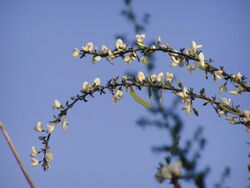Biology:Cytisus multiflorus
| Cytisus multiflorus | |
|---|---|

| |
| Scientific classification | |
| Kingdom: | Plantae |
| Clade: | Tracheophytes |
| Clade: | Angiosperms |
| Clade: | Eudicots |
| Clade: | Rosids |
| Order: | Fabales |
| Family: | Fabaceae |
| Subfamily: | Faboideae |
| Genus: | Cytisus |
| Species: | C. multiflorus
|
| Binomial name | |
| Cytisus multiflorus (L'Hér.) Sweet
| |
| Synonyms[2] | |
|
List
| |
Cytisus multiflorus is a species of legume known by the common names white broom,[3] white spanishbroom[4] and Portuguese broom.[5]
Distribution
It is native to the Iberian Peninsula, especially frequent in the western half in central and northern interior Portugal[6] and central and northern western Spain .[7] It is better known as an introduced species on other continents, including Australia and North America, where it has become a weed in agricultural land and an invasive species in natural habitats.
Description
Cytisus multiflorus is a shrub growing up to 0.8 metres (2 ft 7 in) or 1.5 metres (4 ft 11 in) in sprawling height,[7] with a broomlike array of many five-angled flexible branches. Leaves appear mainly on lower branches, each made up of three leaflets. Some leaves grow on the upper branches; these are generally made up of a single leaflet. Each leaflet is under a centimeter long and may be linear to oblong in shape and coated in soft silvery hairs.
The white, pea-like flower is up to a centimeter long and is often marked with a dark pinkish streak near the base. The fruit is a hairy legume pod up to 3 centimetres (1.2 in) long. The pods turn black with age and dehisce explosively to release their four to six seeds away from the parent plant.
Invasive species
This plant is a serious noxious weed of agricultural fields and a colonizing invasive plant in wild lands in parts of Australia and California ,[8] where it was first introduced as an ornamental shrub for its prolific white flowers. It is still sometimes grown and sold for landscaping purposes despite its status as a pest plant, with new industry and public education programs resulting.[9][10]
Gallery
References
- ↑ Rivers, M.C. (2017). "Cytisus multiflorus". IUCN Red List of Threatened Species 2017: e.T83750589A86135941. doi:10.2305/IUCN.UK.2017-3.RLTS.T83750589A86135941.en. https://www.iucnredlist.org/species/83750589/86135941. Retrieved 20 November 2021.
- ↑ "The Plant List: A Working List of All Plant Species". http://www.theplantlist.org/tpl1.1/record/ild-8771. Retrieved 3 April 2014.
- ↑ (xls) BSBI List 2007, Botanical Society of Britain and Ireland, https://bsbi.org/download/3542/, retrieved 17 October 2014
- ↑ "Cytisus multiflorues". Natural Resources Conservation Service PLANTS Database. USDA. https://plants.usda.gov/core/profile?symbol=CYMU3. Retrieved 17 January 2016.
- ↑ "Cytisus multiflorus (L'Her.) Sweet". Catalogue of Life. https://www.catalogueoflife.org/data/taxon/33RZR.
- ↑ "Cytisus multiflorus (L'Hér.) Sweet". Flora-On. https://flora-on.pt/#/1Cytisus+multiflorus.
- ↑ 7.0 7.1 "Cytisus multiflorus". Flora Iberica. http://www.floraiberica.es/floraiberica/texto/pdfs/07_13%20Cytisus.pdf.
- ↑ Jepson
- ↑ "Weeds in Australia". Australian Weed Management. http://www.weeds.gov.au/publications/guidelines/alert/pubs/c-multiflorus.pdf. Retrieved 24 November 2010.
- ↑ "What are invasive species and why are they a problem?". Calif. Invasive Species Program. http://www.dfg.ca.gov/invasives/. Retrieved 24 November 2010.
External links
| mode = cs1 | title = Cytisus multiflorus | work = Germplasm Resources Information Network (GRIN) | url = | publisher = [[Organization:Agricultural Research ServAgricultural Research Service (ARS), United States Department of Agriculture (USDA) | access-date = }}
Wikidata ☰ Q969060 entry
 |






